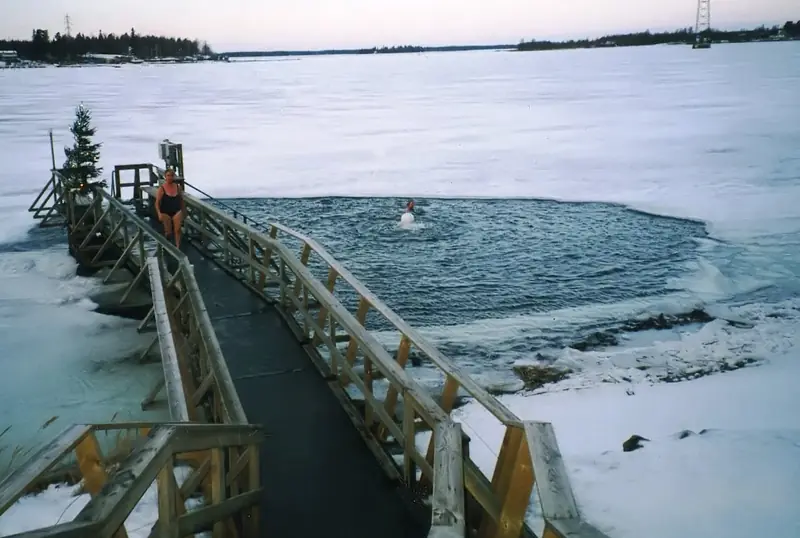
Sensitivity to cold and resistance to stress from low temperatures are individual traits influenced by one’s physiological state and psychological mindset. Therefore, the journey to winter swimming should begin with proper preparation and motivation.
Why is this necessary?
The simplest answer to this question can be found during the Epiphany: on this holiday, the water in the ice hole is considered healing, making a dip in the cold meaningful for strengthening health. Believers often overlook the risk of catching a cold, viewing the icy water as a blessing that washes away sins and heals ailments. The roots of this confidence lie in the mind: a deep and steadfast faith.
Winter swimming enthusiasts, known as “walruses,” are also driven to the ice hole by their convictions. Friends of cold water support the body’s adaptive capabilities in this way. Fans of winter plunges claim they find in icy water a remedy for illnesses, improved well-being, and increased vitality. Medical science backs this up: proper hardening indeed strengthens the body, protects against colds, enhances stress resistance, and boosts immunity. However, not everyone will benefit from immersing in the ice hole, and acclimatization should be gradual.
Health Risks
Medical contraindications for winter swimming include:
- bronchial asthma, pneumonia, emphysema, tuberculosis;
- ear, nose, and throat diseases: otitis, inflammation of the nasopharynx and nasal cavities;
- eye diseases: glaucoma, conjunctivitis;
- inflammation of the appendages or prostate, cystitis, nephritis;
- heart and vascular diseases;
- history of traumatic brain injury, epilepsy, cerebral vascular sclerosis;
- stomach ulcers, cholecystitis, enterocolitis, hepatitis;
- hyperglycemia, diabetes;
- neuritis and polyneuritis;
- venereal diseases.
At-Risk Groups
Extreme swimming in ice holes is dangerous for:
- those under the influence of alcohol;
- individuals who have recently recovered from illness and have weakened, unprepared bodies (risk of pneumonia);
- elderly people (sudden cooling can cause vascular spasms and heart attacks);
- hypertensives and hypotensives (high or low blood pressure can lead to strokes, heart attacks, or hypertensive crises);
- diabetics (cold activates hormone production in the adrenal glands, raising blood sugar levels);
- people with acute inflammations;
- pregnant women;
- children under three years old.
Preparation for Immersion
Do not go to the ice hole alone. It’s best to choose an “organized” swimming area, avoiding unsuitable locations and thin ice (the safe thickness for one person is at least 7-8 centimeters, and for a group, it should be twice that). Ensure easy access to the water: the winter swimming spot should have a gentle slope or stairs. A fence around the swimming area can prevent accidental falls into the water. The depth of the swimming area should not exceed 1.8 meters. Taking precautions will help avoid additional problems in extreme situations.
Prepare for wind protection, and create conditions for drying off and changing into warm clothes after swimming.
Don’t come to swim without a set of dry clothes, a terry towel, and a bathrobe. In addition to a swimsuit or swim trunks, you should have separate footwear to avoid walking on the ice barefoot (slippery rubber soles are not suitable). Experienced swimmers often wear woolen socks from the shore and even enter the water in them. After swimming, quickly change into dry clothes.
Rules for Winter Swimming
After undressing, warm up your muscles: wave your arms, bend, and squat. But avoid sweating: your body should simply warm up.
The water temperature in the ice hole, while above freezing, is still very low: 2-4°C. In cold water, your breathing may initially become irregular: wait for it to normalize before diving in.
Don’t succumb to euphoria (the rush of joy from endorphins is a reaction to the cold) and don’t exceed the recommended swimming time: the first immersion should last no longer than a few seconds.
It’s not mandatory to plunge in headfirst during winter: this is not a rule, but rather a tradition associated with the holiday. Staying outside with wet hair can be dangerous.
After exiting the water, drink some hot tea. Alcohol is prohibited during winter swimming. The common belief that alcohol warms you up is misleading. Rescuers warn that this effect wears off within half an hour after consumption, often leading to the opposite effect.
The Nature of Stress
The essence of “walrusing” as an extreme method of hardening lies in the fact that under conditions of hypothermia, the body adapts to the cold, as well as to other uncomfortable environmental factors: heat, temperature fluctuations, high humidity, and wind. Hardening reduces sensitivity to climate-related discomforts and magnetic storms. It is stress that enhances our adaptive abilities, urgently mobilizing internal resources with maximum functional tension.
It has been proven that systematic “walrusing” increases mitochondrial activity (these are the energy stations of cells) and thereby activates metabolic processes, expelling toxins from the body and rejuvenating it. Experienced “walruses” show increased lung capacity, enhanced muscle strength, and improved performance.
Scientifically Proven
The mechanisms of these changes have been scientifically studied. Since the thermal conductivity of water is nearly thirty times greater than that of air, the body loses heat very quickly during underwater immersion. Short-term exposure to cold slows the pulse (by 15%), increases oxygen intake (by 5-6 times), and enhances heat production (by 10 times) because the constriction of skin blood vessels directs more blood to internal organs.
The adrenal glands’ response to cold stress involves the release of hormones designed to provide urgent support to organs and physiological systems. These hormones are called corticosteroids, known for their high anti-inflammatory potential. This is where the secret to the healing effect of winter swimming lies, as icy water alleviates chronic inflammatory processes. Viral infections in “walruses” occur without complications: recovery happens three times faster than usual. Studies have shown that “walruses” catch colds five times less often: such a preventive effect has not been achieved even with powerful pharmaceutical immune-boosting medications.
